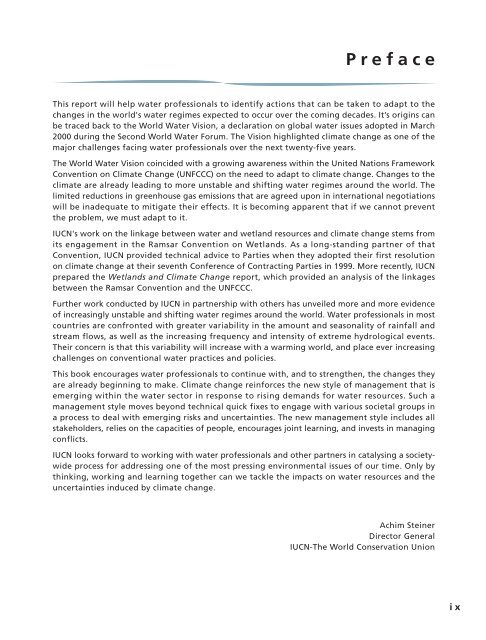Adaptation of water resources management to climate change
Adaptation of water resources management to climate change
Adaptation of water resources management to climate change
You also want an ePaper? Increase the reach of your titles
YUMPU automatically turns print PDFs into web optimized ePapers that Google loves.
PrefaceThis report will help <strong>water</strong> pr<strong>of</strong>essionals <strong>to</strong> identify actions that can be taken <strong>to</strong> adapt <strong>to</strong> the<strong>change</strong>s in the world's <strong>water</strong> regimes expected <strong>to</strong> occur over the coming decades. It’s origins canbe traced back <strong>to</strong> the World Water Vision, a declaration on global <strong>water</strong> issues adopted in March2000 during the Second World Water Forum. The Vision highlighted <strong>climate</strong> <strong>change</strong> as one <strong>of</strong> themajor challenges facing <strong>water</strong> pr<strong>of</strong>essionals over the next twenty-five years.The World Water Vision coincided with a growing awareness within the United Nations FrameworkConvention on Climate Change (UNFCCC) on the need <strong>to</strong> adapt <strong>to</strong> <strong>climate</strong> <strong>change</strong>. Changes <strong>to</strong> the<strong>climate</strong> are already leading <strong>to</strong> more unstable and shifting <strong>water</strong> regimes around the world. Thelimited reductions in greenhouse gas emissions that are agreed upon in international negotiationswill be inadequate <strong>to</strong> mitigate their effects. It is becoming apparent that if we cannot preventthe problem, we must adapt <strong>to</strong> it.IUCN's work on the linkage between <strong>water</strong> and wetland <strong>resources</strong> and <strong>climate</strong> <strong>change</strong> stems fromits engagement in the Ramsar Convention on Wetlands. As a long-standing partner <strong>of</strong> thatConvention, IUCN provided technical advice <strong>to</strong> Parties when they adopted their first resolutionon <strong>climate</strong> <strong>change</strong> at their seventh Conference <strong>of</strong> Contracting Parties in 1999. More recently, IUCNprepared the Wetlands and Climate Change report, which provided an analysis <strong>of</strong> the linkagesbetween the Ramsar Convention and the UNFCCC.Further work conducted by IUCN in partnership with others has unveiled more and more evidence<strong>of</strong> increasingly unstable and shifting <strong>water</strong> regimes around the world. Water pr<strong>of</strong>essionals in mostcountries are confronted with greater variability in the amount and seasonality <strong>of</strong> rainfall andstream flows, as well as the increasing frequency and intensity <strong>of</strong> extreme hydrological events.Their concern is that this variability will increase with a warming world, and place ever increasingchallenges on conventional <strong>water</strong> practices and policies.This book encourages <strong>water</strong> pr<strong>of</strong>essionals <strong>to</strong> continue with, and <strong>to</strong> strengthen, the <strong>change</strong>s theyare already beginning <strong>to</strong> make. Climate <strong>change</strong> reinforces the new style <strong>of</strong> <strong>management</strong> that isemerging within the <strong>water</strong> sec<strong>to</strong>r in response <strong>to</strong> rising demands for <strong>water</strong> <strong>resources</strong>. Such a<strong>management</strong> style moves beyond technical quick fixes <strong>to</strong> engage with various societal groups ina process <strong>to</strong> deal with emerging risks and uncertainties. The new <strong>management</strong> style includes allstakeholders, relies on the capacities <strong>of</strong> people, encourages joint learning, and invests in managingconflicts.IUCN looks forward <strong>to</strong> working with <strong>water</strong> pr<strong>of</strong>essionals and other partners in catalysing a societywideprocess for addressing one <strong>of</strong> the most pressing environmental issues <strong>of</strong> our time. Only bythinking, working and learning <strong>to</strong>gether can we tackle the impacts on <strong>water</strong> <strong>resources</strong> and theuncertainties induced by <strong>climate</strong> <strong>change</strong>.Achim SteinerDirec<strong>to</strong>r GeneralIUCN-The World Conservation Unionix











![View full document [PDF 988.55 KB] - PreventionWeb](https://img.yumpu.com/47733942/1/184x260/view-full-document-pdf-98855-kb-preventionweb.jpg?quality=85)
![View full document (in French) [PDF 4.96 MB] - PreventionWeb](https://img.yumpu.com/47223870/1/184x260/view-full-document-in-french-pdf-496-mb-preventionweb.jpg?quality=85)


![View full document [PDF 25.02 MB] - PreventionWeb](https://img.yumpu.com/44204570/1/190x234/view-full-document-pdf-2502-mb-preventionweb.jpg?quality=85)
